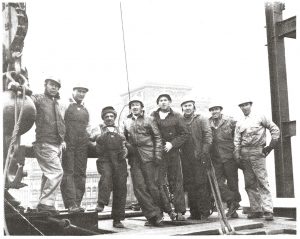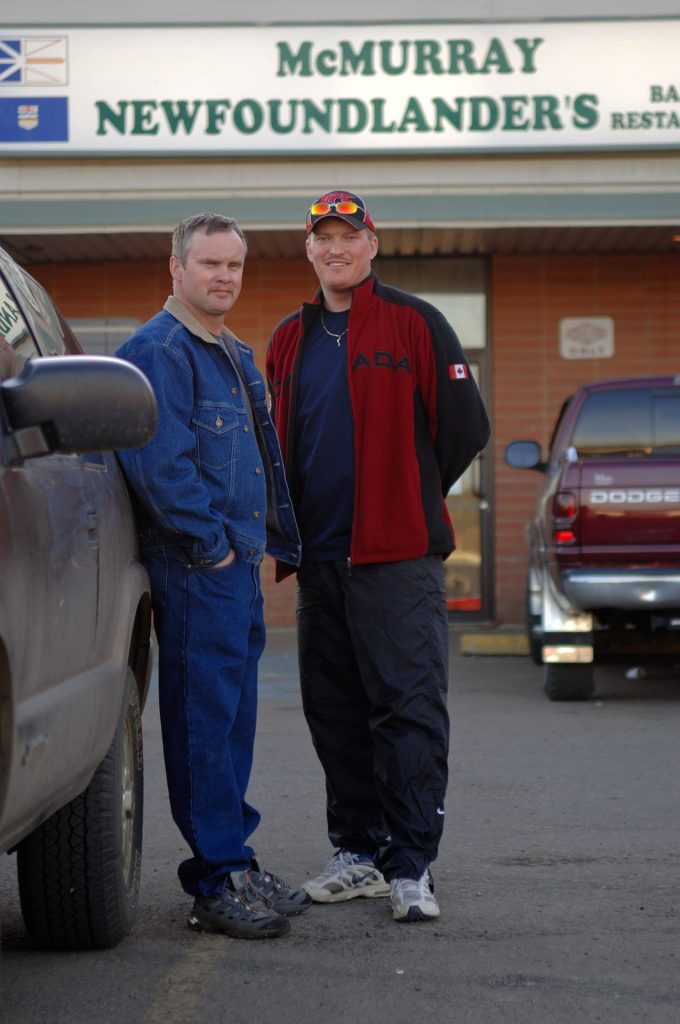December 2020
St John’s, Newfoundland
by Greg Locke
INTRO
In 2006 and 2007 I spent a lot of time travelling in western Canada and northern Alberta in particular. In Fort MacMurray and Grande Prairie I was following the migration of Newfoundlanders as they headed west to work in the oil fields, mines, construction sites, and paper mills.
I met those who were just commuting from Newfoundland on 3 week rotational shifts and living in work camps and those who had been there for 30 years. They reminded me a lot of the other immigrant and ex-pat communities I grew up with in Toronto and worked in around the world. A people detached from their roots but hanging on to what they believed to be an identity of the “old country.”
Newfoundlanders have been emigrating, commuting, and migrating for work for generations. Boston and New England in the mid 1800s, New York and Philadelphia in the 1920s and 1930s. Nova Scotia in the 1940s and 1950s and all across Canada, and around the world, from the 1960s to present day. My grand parents worked in construction and as domestics in New York, my parents moved to southern Ontario to work in the factories in the 1960s. My generation, many with university degrees now, left in the 1980s for white collar tech jobs and even my daughter moved away in 2020 to work in her profession as there was no meaningful work in Newfoundland.
Hundreds of thousands have left. Popular legend says that as many Newfoundlanders have left Newfoundland as currently live here. Approximately a half a million in 2020. Most would never return but many could not resist the pull of their Newfoundland roots and would return home at the first opportunity.
Exit Zero is the term for the last/first ramp on a highway interchange. In St John’s, Newfoundland, Exit Zero is the beginning/end of the Trans-Canada highway at Logy Bay Road a short distance from my home and an apt metaphor for the exit ramp from Newfoundland. In the early 2000s those highway ramps saw the migration of Newfoundlanders with their households packed up in pickup trucks and U-Haul trailers headed to places in western Canada for work. I followed that highway with them.
This project will look at this history of migration, cultural and social identity in the ex-pat community and stories of some of those Newfoundlanders who went down the road.
A HISTORY OF MIGRATION
English, French, Spanish, Basque, Portuguese, Dutch all came to Newfoundland and fought over it for the fish and whales in the rich waters of the north west Atlantic from the 1500s through the 1800s. Thousands of years before them, North America’s First Nations came to the island and coastal Labrador chasing food and resources as they migrated east.
At first the Europeans did not stay. They returned home at the end of the summer avoiding spending the winter. By English law, it was illegal to own property in Newfoundland until 1819. But eventually permanent settlement happened, and trade and commerce meant the movement of products and people between Europe, Newfoundland, the USA and the Caribbean.
The Boston States
 In the mid 1800s, trade between Newfoundland and New England, the “Boston States” as they were called, flourished and eventual permanent migration to the USA’s New England region occurred. As rich as the Newfoundland fishery was, it was controlled by a small group of wealthy merchants and subject to boom and bust cycles. In 1860-1862 the Newfoundland fishery had collapsed starting a six year depression in Newfoundland. Poverty and unpredictability sending many looking for better opportunities in the USA. Places like Boston, Mystic, Gloucester and Salem still have place names and businesses with names that hint of a Newfoundland history.
In the mid 1800s, trade between Newfoundland and New England, the “Boston States” as they were called, flourished and eventual permanent migration to the USA’s New England region occurred. As rich as the Newfoundland fishery was, it was controlled by a small group of wealthy merchants and subject to boom and bust cycles. In 1860-1862 the Newfoundland fishery had collapsed starting a six year depression in Newfoundland. Poverty and unpredictability sending many looking for better opportunities in the USA. Places like Boston, Mystic, Gloucester and Salem still have place names and businesses with names that hint of a Newfoundland history.
The New England trade was also connected to the Caribbean, with schooners carrying salt fish south and sugar north from places like Falmouth, Jamaica. Salt fish is still a part of the Jamaican national dish, Ackee and saltfish.
High Steel
 After WWI a construction boom was happening in the USA and in the major cities of New York, Pittsburgh and Philadelphia the first skyscrapers were being built. Many Newfoundlanders were on the move with the next large migration looking for jobs working the high steel. Places like Conception Harbour would see almost their entire population leave for the USA.
After WWI a construction boom was happening in the USA and in the major cities of New York, Pittsburgh and Philadelphia the first skyscrapers were being built. Many Newfoundlanders were on the move with the next large migration looking for jobs working the high steel. Places like Conception Harbour would see almost their entire population leave for the USA.
Legend has it that the first Newfoundland ironworker was a man named Frank Trahey from Conception Harbour, who sent word back home that there was work and good wages to be had building skyscrapers. By the 1930s, Newfoundlanders represented about a quarter of the membership of Ironworkers Local 40, which covers Manhattan, the Bronx, Staten Island and Westchester County. Newfoundlanders were said to be particularly suited for work on high steel because of their lifetime balancing on boats on the high seas.
This is where my grand parents would meet before returning to Newfoundland to raise their family.
See Cass Trahey Hadiss video, Philadelphia Connection.
Moving to Canada
 With a new island wide railway in 1898 and a ferry service between Port aux Basques on the south west coast of Newfoundland and North Sydney, Nova Scotia, Newfoundlanders had a quick and easy exit off the island. Many Newfoundlanders went to work in the mines in Nova Scotia and onward to the rest of Canada. Often overlooked is the large number of Newfoundlanders that went to Great Britain during World War 2 and decided to stay after the war. Usually getting married and having families. My great uncle, Aubrey Frampton of Catalina, was one of these.
With a new island wide railway in 1898 and a ferry service between Port aux Basques on the south west coast of Newfoundland and North Sydney, Nova Scotia, Newfoundlanders had a quick and easy exit off the island. Many Newfoundlanders went to work in the mines in Nova Scotia and onward to the rest of Canada. Often overlooked is the large number of Newfoundlanders that went to Great Britain during World War 2 and decided to stay after the war. Usually getting married and having families. My great uncle, Aubrey Frampton of Catalina, was one of these.
The next wave of emigration had begun.
After confederation with Canada in 1949, the 1950’s and 1960s saw the movement of labour to the factories of Toronto and surrounding southern Ontario. The town of Cambridge was famous for its Newfoundland communities. It was common for people from the same Newfoundland village to all migrate to the same area. Just like modern immigrants. My parents were a part of this generation of migrant workers. In 1966 my father, Fred Locke, and his friend, Kevin Sullivan of Torbay, in a scene reminiscent of Going Down The Road, loaded up their old Chevy and drove to new lives in Toronto. Ironically, this was also Newfoundland’s “Come Home Year”, a major tourism promotion by the government of Newfoundland. My mother and I would follow later …by train.
In a 1996 documentary, Garden Party on the 401 for CBC Radio, Ted Blades visited the Newfoundland community in Cambridge where they were having their annual garden party. His interviews with the Newfoundlanders reflect the themes I have heard in my travels and in the expat Newfoundland communities in Alberta and those who have committed to migrating instead of choosing to commute on rotational shifts. They are people who all left Newfoundland in their late teens or early twenties and had to leave for economic reasons; not because they wanted to. They needed jobs and there were none in Newfoundland. They left Newfoundland behind …almost.
In these communities there is a lot of nostalgia for a culture they once knew, some thirty years before, but one that does not necessary reflect the current social and cultural reality in Newfoundland. Most have no intention of returning “home”. Their children are not Newfoundlanders, being born in Ontario or Alberta and have all the advantages of living in a large urban area instead or rural and remote Newfoundland. They refer to themselves as “Newfies”. A term no longer acceptable in most circles in Newfoundland.
Some estimates put the number at 400,00 Newfoundlanders living in Southern Ontario.
The New Waves
 Come the 1980’s Ontario was still the destination of choice but now it was well educated health care workers, engineers, artists and high tech workers headed to a new class of jobs in Toronto, Ottawa, Montreal and Vancouver.
Come the 1980’s Ontario was still the destination of choice but now it was well educated health care workers, engineers, artists and high tech workers headed to a new class of jobs in Toronto, Ottawa, Montreal and Vancouver.
Another wave headed to Alberta, BC and NWT for the oil industry, mining and forestry.
By the end of the 1980s the fishery was on the verge of collapse again and in 1992 the Canadian government closed the cod fishery putting an estimated thirty thousand people out of work. This was the largest economic blow to the province since the Great Depression. An estimated 40,000 – 50,000 people have left the province following this historic event. …see A Petty Harbour Story.
Up until the collapse of oil prices in 2019 and the COVID-19 pandemic of 2020 the wages of Newfoundland workers commuting to jobs in western Canada were a major source of income in Newfoundland and Labrador and contributing significantly to the provincial economy. After the local oil industry, tourism and fishery it is the next largest contributor to the Newfoundland economy and very similar to the “remittance economy” of many developing countries where its citizens migrate for work and send the money home.
I have met Newfoundlanders everywhere I have travelled and lived in my life from about 1972 to present day. New York, Miami, Ottawa, Toronto, London, Nairobi and even remote African refugee camps where they were working as aid workers for international relief agencies. I met dozens in Bosnia. Members of UN and NATO peacekeeping forces. It’s a fascinating history and story.
See stories Moving Labour, and A Petty Harbour Story
Video interview with Dr Jim Overton
THE LONG COMMUTE
 In the 2000s a new breed of worker emerged. Newfoundlanders who did not move away for work but commuted to work on 2-4 week rotational shifts, living in work camps, and returning to live in Newfoundland with their families during the weeks off. This not only means “fly-in” heavy industry work sites in oil or mining operations in Alberta, BC or NWT but also health care and fish plant workers in closer locations such as Nova Scotia and New Brunswick.
In the 2000s a new breed of worker emerged. Newfoundlanders who did not move away for work but commuted to work on 2-4 week rotational shifts, living in work camps, and returning to live in Newfoundland with their families during the weeks off. This not only means “fly-in” heavy industry work sites in oil or mining operations in Alberta, BC or NWT but also health care and fish plant workers in closer locations such as Nova Scotia and New Brunswick.
For a deeper dive into the numbers, locations and labour sectors of Newfoundlander travelling to work across Canada in 2020 download these working papers from On The Move Partnership at Memorial University.
Inter-jurisdictional Employment in Canada 2002 to 2016 (pdf)
Inter-provincial employees from Newfoundland and Labrador 2005‑2014 (pdf)
In 2020 COVID-19 pandemic struck complicating travel for rotational workers. The close quarters of work camps were a breeding ground for the disease and workers were bringing it back to Newfoundland forcing strict isolation regulations for returning workers. This also resulted in suspicion and derision in some public and social circles of the workers.
Check out these reports, also from On The Move Partnership,
Mobile Workers in Alberta During the Covid 19 Pandemic
Covid-19 and (Im)Mobile Workers in Alberta’s Essential Oil Industry.
DRAWN HOME
As many leave, many return home. …or wish they could. They never lose the dream of returning to Newfoundland even if they never make the trip. Some say its an “island people” thing. Whatever the reason the draw is strong. Newfoundland society and culture is unique in Canada and for many they are just fish out of water elsewhere. Regardless of its small town troubles and parochial provincial attitudes many people need that sense of belonging and being with their own people to feel whole.
 After many years living away a chance assignment and extended stay back in St. John’s made me realize how much I belong to Newfoundland …not just being from there. A Newfoundlander will not ask you where you are from. He’ll ask, “…now, where do you belong.”
After many years living away a chance assignment and extended stay back in St. John’s made me realize how much I belong to Newfoundland …not just being from there. A Newfoundlander will not ask you where you are from. He’ll ask, “…now, where do you belong.”
Like young people in any small, rural or remote location they have a desire to “get out”. Be it seeking adventure, an education or simply a job. Some do so with the longing to return home some day but many never come back to Newfoundland, even for vacation or for family funerals.
People go, stay, and return for lots of reasons. Nostalgia is strong but many have it for a Newfoundland that doesn’t exist any more. Some prominent Newfoundland artists who have moved and do their work away from Newfoundland have said they are inspired by Newfoundland that doesn’t exist anymore.
In our interview with Dr Jim Overton about migration he talked about this “idea of Newfoundland” and “concepts of home” and says, “the place you left is not the place you go back to.”
I think the travelling, the going and returning multiple times has taught me as much about where I was from as it did the places I was visiting. At some point you need to touch base with your own society and culture back home to keep you whole …like it or not.
See video interviews with Dr Jim Overton, and Anne Locke.
The On The Move Partnership at Memorial University of Newfoundland has done extensive research and academic study on Newfoundland’s rotational labour force Visit their website for a deeper dive into the statistics, economic and social impact of migratory labour.
This website will be active and we will add stories and news of Newfoundland emigration and labour migrations as they occur.
We can be reached at mail@exitzeroproject.ca


